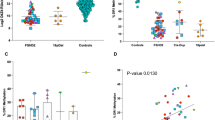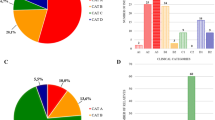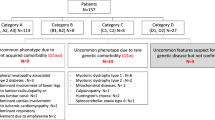Abstract
Molecular pathophysiology of facioscapulohumeral muscular dystrophy (FSHD) involves the heterozygous contraction of the number of tandemly repeated D4Z4 units at chromosome 4q35.2. FSHD is associated with a range of 1–10 D4Z4 units instead of 11–150 in normal controls. Several factors complicate FSHD molecular diagnosis, especially the cis-segregation of D4Z4 contraction with a 4qA allele, whereas D4Z4 shortening is silent both on alleles 4qB and 10q. Discrimination of pathogenic 4q-D4Z4 alleles from highly homologous 10q-D4Z4 arrays requires the use of the conventional Southern blot, which is not suitable at the single-cell level. Preimplantation genetic diagnosis (PGD) is a frequent request from FSHD families with several affected relatives. We aimed to develop a rapid and sensitive PCR-based multiplex approach on single cells to perform an indirect familial segregation study of pathogenic alleles. Among several available polymorphic markers at 4q35.2, the four most proximal (D4S2390, D4S1652, D4S2930 and D4S1523, <1.23 Mb) showing the highest heterozygote frequencies (67–91%) were selected. Five recombination events in the D4S2390-D4S1523 interval were observed among 144 meioses. In the D4S2390-D4Z4 interval, no recombination event occurred among 28 FSHD meioses. Instead, a particular haplotype segregated with both clinical and molecular status, allowing the characterization of an at-risk allele in each tested FSHD family (maximal LOD score 2.98 for θ=0.0). This indirect protocol can easily complement conventional techniques in prenatal diagnosis. Although our multiplex PCR-based approach technically fulfils guidelines for single-cell analysis, the relatively high recombination risk hampers its application to PGD.
Similar content being viewed by others
Log in or create a free account to read this content
Gain free access to this article, as well as selected content from this journal and more on nature.com
or
References
Lunt PW, Compston DA, Harper PS : Estimation of age dependent penetrance in facioscapulohumeral muscular dystrophy by minimising ascertainment bias. J Med Genet 1989; 26: 755–760.
Tonini MM, Passos-Bueno MR, Cerqueira A, Matioli SR, Pavanello R, Zatz M : Asymptomatic carriers and gender differences in facioscapulohumeral muscular dystrophy (FSHD). Neuromuscul Disord 2004; 14: 33–38.
Gilbert JR, Stajich JM, Wall S et al: Evidence for heterogeneity in facioscapulohumeral muscular dystrophy (FSHD). Am J Hum Genet 1993; 53: 401–408.
Mills KA, Buetow KH, Xu Y et al: Genetic and physical mapping on chromosome 4 narrows the localization of the gene for facioscapulohumeral muscular dystrophy (FSHD). Am J Hum Genet 1992; 51: 432–439.
Sarfarazi M, Wijmenga C, Upadhyaya M et al: Regional mapping of facioscapulohumeral muscular dystrophy gene on 4q35: combined analysis of an international consortium. Am J Hum Genet 1992; 51: 396–403.
van Deutekom JC, Wijmenga C, van Tienhoven EA et al: FSHD associated DNA rearrangements are due to deletions of integral copies of a 3.2 kb tandemly repeated unit. Hum Mol Genet 1993; 2: 2037–2042.
Weiffenbach B, Bagley R, Falls K et al: Linkage analyses of five chromosome 4 markers localizes the facioscapulohumeral muscular dystrophy (FSHD) gene to distal 4q35. Am J Hum Genet 1992; 51: 416–423.
Wijmenga C, Frants RR, Hewitt JE et al: Molecular genetics of facioscapulohumeral muscular dystrophy. Neuromuscul Disord 1993; 3: 487–491.
Butz M, Koch MC, Muller-Felber W, Lemmers RJ, van der Maarel SM, Schreiber H : Facioscapulohumeral muscular dystrophy. Phenotype-genotype correlation in patients with borderline D4Z4 repeat numbers. J Neurol 2003; 250: 932–937.
Klinge L, Eagle M, Haggerty ID, Roberts CE, Straub V, Bushby KM : Severe phenotype in infantile facioscapulohumeral muscular dystrophy. Neuromuscul Disord 2006; 16: 553–558.
Lemmers RJ, Osborn M, Haaf T et al: D4F104S1 deletion in facioscapulohumeral muscular dystrophy: phenotype, size, and detection. Neurology 2003; 61: 178–183.
Lunt PW, Jardine PE, Koch M et al: Phenotypic-genotypic correlation will assist genetic counseling in 4q35-facioscapulohumeral muscular dystrophy. Muscle Nerve 1995; 2: S103–S109.
Ricci E, Galluzzi G, Deidda G et al: Progress in the molecular diagnosis of facioscapulohumeral muscular dystrophy and correlation between the number of KpnI repeats at the 4q35 locus and clinical phenotype. Ann Neurol 1999; 45: 751–757.
Bakker E, Wijmenga C, Vossen RH et al: The FSHD-linked locus D4F104S1 (p13E-11) on 4q35 has a homologue on 10qter. Muscle Nerve 1995; 2: S39–S44.
Deidda G, Cacurri S, Grisanti P, Vigneti E, Piazzo N, Felicetti L : Physical mapping evidence for a duplicated region on chromosome 10qter showing high homology with the facioscapulohumeral muscular dystrophy locus on chromosome 4qter. Eur J Hum Genet 1995; 3: 155–167.
Felice KJ, Jones JM, Conway SR : Facioscapulohumeral dystrophy presenting as infantile facial diplegia and late-onset limb-girdle myopathy in members of the same family. Muscle Nerve 2005; 32: 368–372.
Lemmers RJ, van der Maarel SM, van Deutekom JC et al: Inter- and intrachromosomal sub-telomeric rearrangements on 4q35: implications for facioscapulohumeral muscular dystrophy (FSHD) aetiology and diagnosis. Hum Mol Genet 1998; 7: 1207–1214.
Lemmers RJ, Van Overveld PG, Sandkuijl LA et al: Mechanism and timing of mitotic rearrangements in the subtelomeric D4Z4 repeat involved in facioscapulohumeral muscular dystrophy. Am J Hum Genet 2004; 75: 44–53.
van der Maarel SM, Deidda G, Lemmers RJ et al: De novo facioscapulohumeral muscular dystrophy: frequent somatic mosaicism, sex-dependent phenotype, and the role of mitotic transchromosomal repeat interaction between chromosomes 4 and 10. Am J Hum Genet 2000; 66: 26–35.
Tupler R, Berardinelli A, Barbierato L et al: Monosomy of distal 4q does not cause facioscapulohumeral muscular dystrophy. J Med Genet 1996; 33: 366–370.
Petrov A, Pirozhkova I, Carnac G, Laoudj D, Lipinski M, Vassetzky YS : Chromatin loop domain organization within the 4q35 locus in facioscapulohumeral dystrophy patients versus normal human myoblasts. Proc Natl Acad Sci USA 2006; 103: 6982–6987.
de Greef JC, Frants RR, van der Maarel SM : Epigenetic mechanisms of facioscapulohumeral muscular dystrophy. Mutat Res 2008; 647: 94–102.
Dmitriev P, Lipinski M, Vassetzky YS : Pearls in the junk: dissecting the molecular pathogenesis of facioscapulohumeral muscular dystrophy. Neuromuscul Disord 2009; 19: 17–20.
Pirozhkova I, Petrov A, Dmitriev P, Laoudj D, Lipinski M, Vassetzky Y : A functional role for 4qA/B in the structural rearrangement of the 4q35 region and in the regulation of FRG1 and ANT1 in facioscapulohumeral dystrophy. PLoS ONE 2008; 3: e3389.
Lemmers RJ, de Kievit P, Sandkuijl L et al: Facioscapulohumeral muscular dystrophy is uniquely associated with one of the two variants of the 4q subtelomere. Nat Genet 2002; 32: 235–236.
Lemmers RJ, Wohlgemuth M, Frants RR, Padberg GW, Morava E, van der Maarel SM : Contractions of D4Z4 on 4qB subtelomeres do not cause facioscapulohumeral muscular dystrophy. Am J Hum Genet 2004; 75: 1124–1130.
Thomas NS, Wiseman K, Spurlock G, MacDonald M, Ustek D, Upadhyaya M : A large patient study confirming that facioscapulohumeral muscular dystrophy (FSHD) disease expression is almost exclusively associated with an FSHD locus located on a 4qA-defined 4qter subtelomere. J Med Genet 2007; 44: 215–218.
Lemmers RJ, Wohlgemuth M, van der Gaag KJ et al: Specific sequence variations within the 4q35 region are associated with facioscapulohumeral muscular dystrophy. Am J Hum Genet 2007; 81: 884–894.
Ehrlich M, Jackson K, Tsumagari K, Camano P, Lemmers RJ : Hybridization analysis of D4Z4 repeat arrays linked to FSHD. Chromosoma 2007; 116: 107–116.
Lemmers RJ, van der Wielen MJ, Bakker E, Frants RR, van der Maarel SM : Rapid and accurate diagnosis of facioscapulohumeral muscular dystrophy. Neuromuscul Disord 2006; 16: 615–617; author reply 617–618.
Girardet A, Hamamah S, Anahory T et al: First preimplantation genetic diagnosis of hereditary retinoblastoma using informative microsatellite markers. Mol Hum Reprod 2003; 9: 111–116.
Cui XF, Li HH, Goradia TM et al: Single-sperm typing: determination of genetic distance between the G gamma-globin and parathyroid hormone loci by using the polymerase chain reaction and allele-specific oligomers. Proc Natl Acad Sci USA 1989; 86: 9389–9393.
Lathrop GM, Lalouel JM, Julier C, Ott J : Multilocus linkage analysis in humans: detection of linkage and estimation of recombination. Am J Hum Genet 1985; 37: 482–498.
Goto K, Nishino I, Hayashi YK : Rapid and accurate diagnosis of facioscapulohumeral muscular dystrophy. Neuromuscul Disord 2006; 16: 256–261.
Ki CS, Lee ST, Kim KS et al: Clinical and genetic analysis of korean patients with facioscapulohumeral muscular dystrophy. J Korean Med Sci 2008; 23: 959–963.
Lemmers RJ, van der Wielen MJ, Bakker E, Padberg GW, Frants RR, van der Maarel SM : Somatic mosaicism in FSHD often goes undetected. Ann Neurol 2004; 55: 845–850.
Thornhill AR, deDie-Smulders CE, Geraedts JP et al: ESHRE PGD Consortium ‘Best practice guidelines for clinical preimplantation genetic diagnosis (PGD) and preimplantation genetic screening (PGS)’. Hum Reprod 2005; 20: 35–48.
Dean FB, Hosono S, Fang L et al: Comprehensive human genome amplification using multiple displacement amplification. Proc Natl Acad Sci USA 2002; 99: 5261–5266.
Coskun S, Alsmadi O : Whole genome amplification from a single cell: a new era for preimplantation genetic diagnosis. Prenat Diagn 2007; 27: 297–302.
Handyside AH, Robinson MD, Simpson RJ et al: Isothermal whole genome amplification from single and small numbers of cells: a new era for preimplantation genetic diagnosis of inherited disease. Mol Hum Reprod 2004; 10: 767–772.
Hellani A, Coskun S, Benkhalifa M et al: Multiple displacement amplification on single cell and possible PGD applications. Mol Hum Reprod 2004; 10: 847–852.
Hellani A, Coskun S, Tbakhi A, Al-Hassan S : Clinical application of multiple displacement amplification in preimplantation genetic diagnosis. Reprod Biomed Online 2005; 10: 376–380.
Jiao Z, Zhou C, Li J et al: Birth of healthy children after preimplantation diagnosis of beta-thalassemia by whole-genome amplification. Prenat Diagn 2003; 23: 646–651.
Renwick P, Ogilvie CM : Preimplantation genetic diagnosis for monogenic diseases: overview and emerging issues. Expert Rev Mol Diagn 2007; 7: 33–43.
Wells D, Sherlock JK : Strategies for preimplantation genetic diagnosis of single gene disorders by DNA amplification. Prenat Diagn 1998; 18: 1389–1401.
Acknowledgements
This research was supported in part by the ‘Association Française contre les Myopathies’ (AFM).
Author information
Authors and Affiliations
Corresponding author
Ethics declarations
Competing interests
The authors declare no conflict of interest.
Rights and permissions
About this article
Cite this article
Barat-Houari, M., Nguyen, K., Bernard, R. et al. New multiplex PCR-based protocol allowing indirect diagnosis of FSHD on single cells: can PGD be offered despite high risk of recombination?. Eur J Hum Genet 18, 533–538 (2010). https://doi.org/10.1038/ejhg.2009.207
Received:
Revised:
Accepted:
Published:
Issue date:
DOI: https://doi.org/10.1038/ejhg.2009.207



